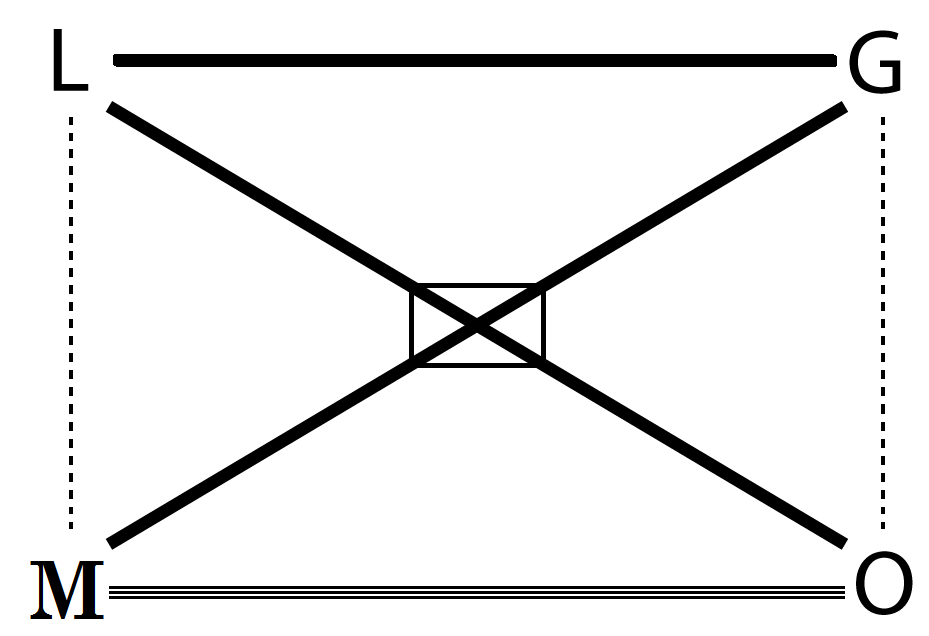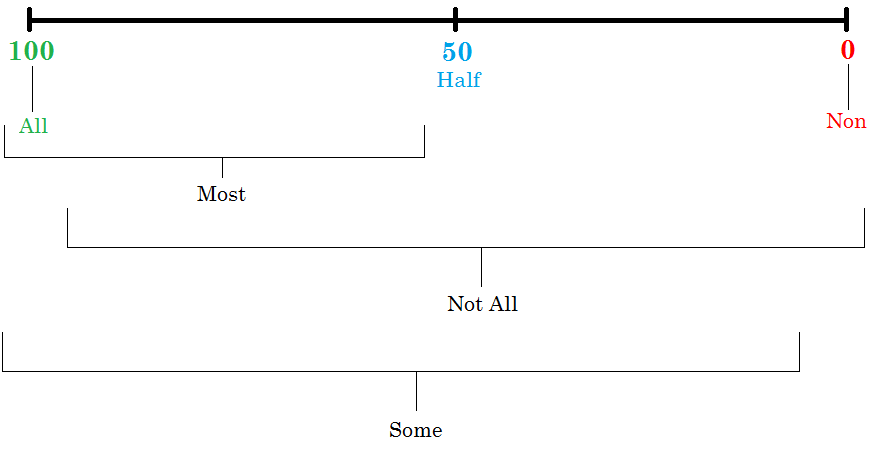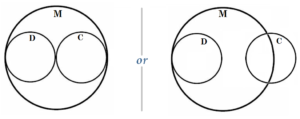Basics of Logic: Lesson-01
Foundation of Logic
If let’s say
L = All mangoes are tasty
G = None of the mangoes is tasty
M = Some mangoes are tasty
O = Some of the mangoes are not tasty
The relationship between these statements are shown in the diagram below:


Contradictory Statements
Two statements are said to be contradictory if one is true, the other becomes false.
Example of Contradiction
| If Statement L is True | ➩ | Statement G MUST be False. |
If it is confirmed that “All mangoes are tasty”, then it MUST be False to say “No mango is tasty”.
Similarly,
| If Statement G is True | ➩ | Statement L MUST be False. |
If it is confirmed that ‘No mango is tasty’, then it becomes False to say“All mangoes are tasty”.
In fact, if not all 100% mangoes are tasty, then perhaps 99% are tasty, 75% are tasty, 50% or even less. Moreover, it can also be possible that 0% mango is tasty. However, it is just a possibility that “no mango is tasty”, but not the confirmation. Hence, it is not ‘MUST be True’ to say that no mango is tasty.
Hence, two statements are said to be contradictory if both cannot be True simultaneously. However, both statements can be False at a time.
For instance,
Remember that if Statement L is False, then Statement G is Not Necessarily True, i.e. Statement G can also be False.
In this case, Statement G Could be True, instead of MUST be True.
For instance,
If it is confirmed that ‘All mangoes are tasty’ is False, then it does not necessarily mean that ‘No mango is tasty’.
This is because if “all mangoes are tasty” is false, which means that at least one mango is not tasty. “AT LEAST one” means one or more. So, it can be from 1% to 100% mangoes that are not tasty. You will understand this key concept with diagram at the end of this lesson.
Similarly,
| If Statement G is false | ➩ | Statement L is not necessarily true. |
If ‘No mango is tasty’ is False, then ‘All mangoes are tasty’ is not necessarily true.
Basically, the opposite of ‘All’ is ‘NOT all’. In other words, the opposite of ‘100%’ is ‘Not 100%’, which not necessarily means 0%. It may be 99%, 98%, 97%, ….., or 0%. Therefore, ‘NOT all’ does not necessarily mean 0%.
Takeaways
For two statements being contradictory to each others:
- If one statement is True, the other statement MUST be False ➩ both statements cannot be true simultaneously.
- If one statement is False, the other statement may either be True or False — again both statements cannot be True simultaneously.
- Two contradictory statements CAN BE False simultaneously.
Sub-contrary Statement:
Two statements are sub-contrary to each others, if both are saying opposite points; but when one statement is true, the other statement is not necessarily false. For instance,
| If Statement M is true | ➩ | Statement O is not necessarily false, despite being opposite to M. |
If ‘Some mangoes are tasty’ is True, then ‘Some mangoes are not tasty’ is not necessarily false.
Similarly,
| If Statement O is true | ➩ | Statement M is not necessarily false, despite being the opposite of Statement O. |
If ‘Some mangoes are not tasty’ is True, then ‘Some mangoes are tasty’ is not necessarily false.
However, in sub-contrary statements:
| If Statement M is false | ➩ | Statement O MUST be true. |
If ‘Some mangoes are tasty’ is false, then ‘Some mangoes are not tasty’ MUST be true.
Similarly,
| If Statement O is false | ➩ | Statement M Must be true. |
If ‘Some mangoes are not tasty’ is false, then ‘Some mangoes are tasty’ MUST be true.
Sub-alternative Statements:
A statement is said to be sub-alternative of the other, if the other statement is true then that statement must also be true. However the reverse scenario does not necessarily hold. For instance,
| If Statement L is true | ➩ | Statement M MUST also be true. |
If ‘All mangoes are tasty’ is true, then ‘Some mangoes are tasty’ MUST also be true.
However,
| If Statement M is true | ➩ | Statement L is not necessarily true. |
If ‘Some mangoes are tasty’ is true, then ‘All mangoes are tasty’ is not necessarily true.
Also note that,
| If Statement L is false | ➩ | Statement M is not necessarily false. |
If ‘All mangoes are tasty’ is false, then ‘Some mangoes are tasty’ is not necessarily false.
However,
| If Statement M is false | ➩ | Statement L MUST also be false. |
If ‘Some mangoes are tasty’ is false, then ‘All mangoes are tasty’ MUST also be false.
Don’t worry if you still find it hard to understand. Let’s discuss it through diagrammatic approach.
From the diagram above, we can conclude that:
| If Statement L is True | ➩ | Both Statement G & Statement O MUST be False. |
Because both Statement G and Statement O are contradictory to Statement L.
Similarly,
| If Statement G is true | ➩ | Both Statement L & Statement M MUST be False. |
Because both Statement L and Statement M are contradictory to Statement G.
All in all,
(Statement L & Statement G), (Statement L & Statement O), and (Statement M & Statement G), are contradictory statements.
(Statement M & Statement O) are sub-contraries.
And,
Statement M is sub-alternative to L
Statement O is sub-alternative to G
Thus, if “All people believe that XYZ…” ➩ It is True to say that “Some people believe that XYZ…”
However, reverse case does not hold true. i.e.:
if “Some people believe that XYZ…” does not imply “All people believe that XYZ…”
Let’s understand it further in terms of numbers,
If there are 100 people. And it is said that “Some people believe XYZ…”
Here, Some people = 1 to 100 people inclusive = At least 1 person = Every possibility except 0.
Similarly,
If there are 100 people. And it is said that “Many people believe XYZ…”
Here, Many people = More than 50 = 51 to 100 inclusive = At least 51 = More than 50%
Similarly,
If there are 100 people. And it is said that “Not all people believe XYZ…”
Here, Not all people = Not 100% = 0 to 99 inclusive = Less than 100%
Let’s understand it through overlapping sets (i.e Venn diagram), so that you’ll get full grip on basics of logic.
All F is A. (Or you may call it as: All football fans are alcoholic.)
Diagrammatically, we may draw it as follow:
From this statement, we cannot conclude “All A is F“, but we can confirm at least “Some A is F“.
No F is A. (Or you may call it as: No football fans is alcoholic.)
Diagrammatically,
From this statement, we cannot conclude “Some A is F“, but we can confirm that “Some A is not F“. Because as we said, some may equals 100%, 1%, or between 1 and 100 percentages, so “No F is A“ suggests that “Some A is not F“.
The below point is very important that mostly tested in critical reasoning / logical reasoning in exams.
Some F is A. (Or you may call it as: Some football fans are alcoholic.)
Diagrammatically,
From this statement, we cannot conclude “Some A is not F“, because it might be possible that whole of circle A inscribed in Circle F (i.e placed totally in circle F, if circle A is smaller than F). But we can confirm that “Some A is F“.
Also this below point is extremely important.
Some F is not A. (Or you may call it as: Some football fans are not alcoholic.)
Diagrammatically,
From this statement, we cannot conclude “Some A is F“, but we can confirm that “Some A is not F“.
We’re not in a mood to tease you further in such things. 🙂
So let’s discuss a final scenario where many people confuse.
No non-alcoholic is football fan. (Generally speaking: No non-A is F)
Diagrammatically, it’s the same as “All football fans are alcoholic”, because it means “no out-sided region of A belongs to F” i.e.

We re sure your commonsense is now getting on the right track, if it wasn’t before. 🙂
Takeaways
- The opposite of ‘All’ is ‘Not all’, which COULD be between 0 and 99 inclusive.
- The extreme opposite of ‘All’ is ‘Non’, which is 0.
- ‘Not all’ ≠ ‘Non’
- All mangoes are tasty = No mango is non-tasty
- Not all ≠ only 0; Not all means not 100%, therefore, it may be 99% or 0%.











